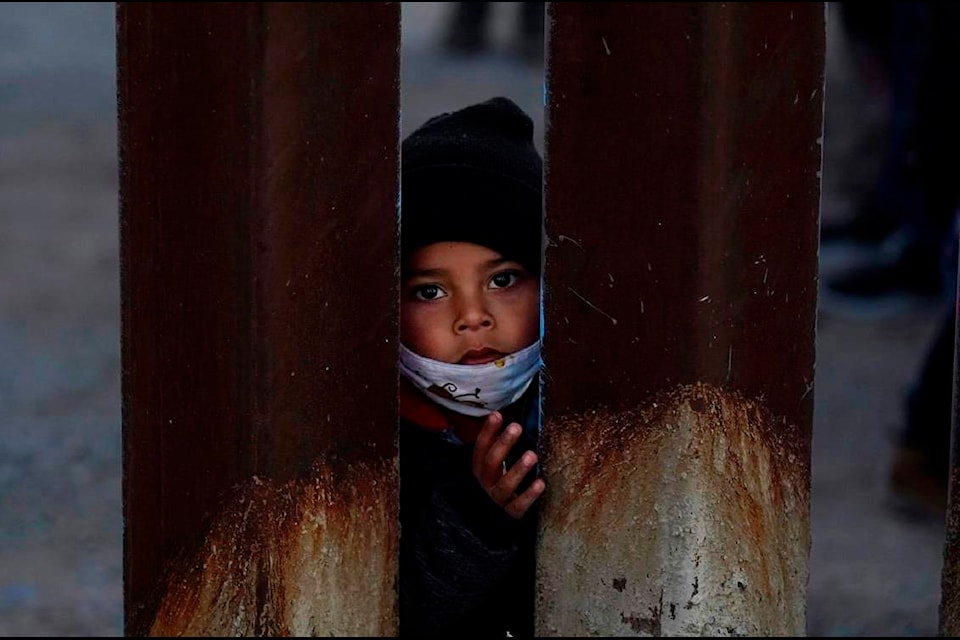To slow the spread of COVID-19, the United States, Canada and Mexico agreed in March to close their shared borders to nonessential travel.
Nine months later, it’s Christmas. Families across the world are disconnected, but perhaps none more than those trapped on opposite sides of an international border. Some legally can’t cross, and others can’t afford to endure quarantines if they do.
Yet, the holiday spirit survives. Along both borders, AP photographers found families connecting in smaller, more intimate ways, overcoming unusual obstacles for shared celebrations.
At the U.S.-Mexico border, most years bring festive Las Posadas celebrations; the centuries-old tradition practiced in Mexico reenacts through song Mary and Joseph’s search for refuge in Bethlehem.
Not this year. In addition to virus-related restrictions, people face another barrier: President Donald Trump’s border wall that stretches hundreds of miles and is still under construction.
A little girl in Arizona recently stuck her arm through giant steel slats of the border wall, wrangling a baby doll as she looked to the sky. A little boy reached through the wall for a hug, looking tired and serious.
Contrast that with the scenes 2,500 miles (4,023 kilometres) away on the U.S.-Canada border.
A short strip of yellow police tape is the only thing dividing Derby Line, Vermont, and Stanstead, Quebec.
On a recent day, the mood outside the majestic, Victorian-style library where people from both countries come to congregate was festive and lighthearted.
A family unfolded chairs in the snow, bundled in winter coats on both sides of the border. They cheerfully exchanged Christmas cards across the police tape, chatting amiably as if there were no barrier.
A Canadian border policeman came by but only to make someone move their car.
The motivations for meeting this way vary: Dr. Tamsin Durand, a physician at a Vermont hospital, visited with her Canadian parents across the yellow tape, unwilling to enter Canada because it would trigger a two-week quarantine. So she, her husband and 3-year-old son, come to visit.
Travel 2,800 miles (4,506 kilometres) west, to Peace Arch Historical State Park in Blaine, Washington, where Canadians walked from a street parallel to the border across a rain-soaked ditch separating the two countries, many carrying tents, sleeping bags, food and other belongings for a visit with Americans.
To enter the U.S., they navigated a short but slippery downhill. Royal Canadian Mounted Police officers checked identification documents of Canadians as they returned. A sign that read “Leaving United States Border” reminded them of the international divide.
Couples romanced in the park; children played. Faith Dancey of White Rock, British Columbia, was all smiles with her bridal gown blowing in the wind as she walked across neatly groomed grass with her new husband. Drew MacPherson of Bellingham, Washington, gave her a joyful piggyback ride before her return to Canada. He stayed in the United States.
It’s not so simple at the Mexico border. In Calexico, California, a planned cross-border celebration happened only in the U.S. because a construction site blocked access to participants in Mexicali, Mexico, a sprawling industrial city of 1 million people.
About a dozen mask-wearing people waited in Calexico to celebrate with Mexicans on Dec. 12, the day of Mexico’s patron saint, Our Lady of Guadalupe. The Americans gathered on the other side, too far to see or speak to their loved ones, and rallied for open borders.
They left behind flowers and candles. They touched the wall before departing.
Like us on Facebook and follow us on Twitter.
Want to support local journalism? Make a donation here.
